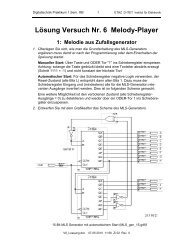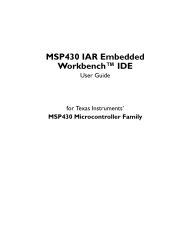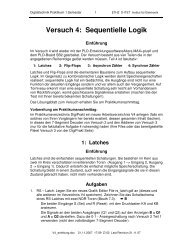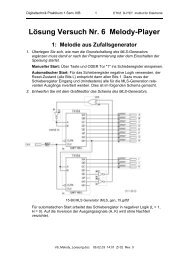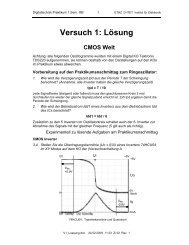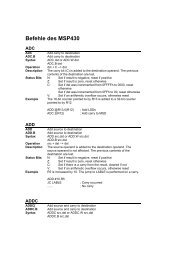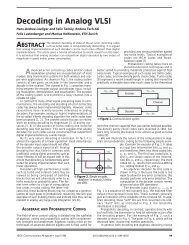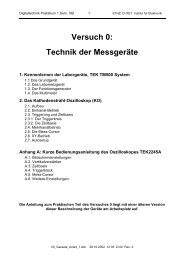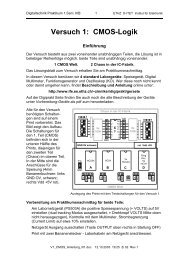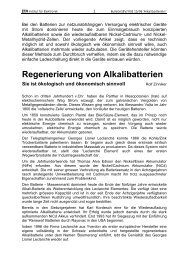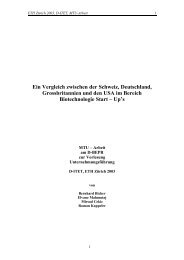InP/InGaAs Single HBT Technology for Photoreceiver OEIC's at 40 ...
InP/InGaAs Single HBT Technology for Photoreceiver OEIC's at 40 ...
InP/InGaAs Single HBT Technology for Photoreceiver OEIC's at 40 ...
You also want an ePaper? Increase the reach of your titles
YUMPU automatically turns print PDFs into web optimized ePapers that Google loves.
IEEE JOURNAL OF LIGHTWAVE TECHNOLOGY, VOL. ??, NO. ??, MONTH YEAR 1<br />
<strong>InP</strong>/<strong>InGaAs</strong> <strong>Single</strong> <strong>HBT</strong> <strong>Technology</strong> <strong>for</strong><br />
<strong>Photoreceiver</strong> OEIC’s <strong>at</strong> <strong>40</strong> Gb/s and Beyond<br />
D. Huber, R. Bauknecht, C. Bergamaschi, M. Bitter, A. Huber,<br />
T. Morf, A. Neiger, M. Rohner, I. Schnyder, V. Schwarz, and H. Jäckel<br />
Abstract— We describe an advanced <strong>InP</strong>/<strong>InGaAs</strong> based technology <strong>for</strong><br />
the monolithic integr<strong>at</strong>ion of pin-photodiodes and S<strong>HBT</strong>-transistors. Both<br />
devices are processed using the same epitaxial grown layer structure.<br />
Employing this technology, we have designed and fabric<strong>at</strong>ed two photoreceivers<br />
achieving transimpedance gains of / and optical/electrical<br />
bandwidths of / . To the best of our knowledge,<br />
this is the highest bandwidth of any <strong>HBT</strong>-based photoreceiver OEIC<br />
published to d<strong>at</strong>e. We even predict a bandwidth of <strong>for</strong> the same<br />
circuit topology by a simple reduction of the photodiode diameter and an<br />
adjustment of the feedback resistor value.<br />
Keywords—Transimpedance amplifier, <strong>Photoreceiver</strong>, OEIC, <strong>HBT</strong>, <strong>InP</strong>,<br />
Processing<br />
I. INTRODUCTION<br />
<strong>Photoreceiver</strong> circuits are key-components in fibre optic<br />
transmission systems. The exponentially growing demand <strong>for</strong><br />
higher d<strong>at</strong>a r<strong>at</strong>es makes bandwidth to the most important figure<br />
of merit <strong>for</strong> such OEIC, whereas sensitivity and gain have<br />
become a slightly lower priority due to the introduction of Erbium<br />
doped fiber amplifiers (EDFA’s). Being the first amplific<strong>at</strong>ion<br />
stage in a chain, the noise figure of the optical amplifier<br />
domin<strong>at</strong>es the overall sensitivity of the system. In addition,<br />
optical gains of and more achieved by EDFA’s<br />
relax the gain requirements <strong>for</strong> following electrical stages. Figure<br />
1 shows a comparison of published receiver per<strong>for</strong>mances in<br />
terms of optical/electrical bandwidth and conversion gain. Because<br />
the conversion gain is the product of transimpedance gain<br />
and photodiode-responsivity, it characterizes the entire receiver<br />
OEIC and not only the preamplifier as the transimpedance gain<br />
does.<br />
HEMT’s and <strong>HBT</strong>’s are both promising candid<strong>at</strong>es to push<br />
receiver bandwidths up to and beyond [1], [11]<br />
(Fig. 1). In general, the high frequency noise behaviour of<br />
HEMT’s is better enabling potentially higher sensitivities of<br />
such receivers. However, reported highest values are comparable<br />
<strong>for</strong> both technologies:<br />
<strong>at</strong> <strong>for</strong> <strong>HBT</strong>-OEIC [8] and<br />
<strong>at</strong> <strong>for</strong> HEMT-OEIC [12], [17], respectively.<br />
Furthermore, the minimum dimensions of HEMT’s<br />
(g<strong>at</strong>e width) are much smaller than the minimum emitter width<br />
of comparable <strong>HBT</strong>’s leading to more relaxed lithography requirements<br />
<strong>for</strong> the <strong>HBT</strong> fabric<strong>at</strong>ion. And the g<strong>at</strong>e threshold volt-<br />
Manuscript received ???, revised ???<br />
D. Huber, A. Huber, T. Morf, A. Neiger, M. Rohner, I. Schnyder, V. Schwarz<br />
and H. Jäckel are with the Electronics Labor<strong>at</strong>ory, Swiss Federal Institute of<br />
<strong>Technology</strong> Zürich (ETHZ), Gloriastr. 35, CH-8092 Zürich, Switzerland<br />
M. Bitter is with the Institute of Quantum Electronics, Micro- and Optoelectronics<br />
Labor<strong>at</strong>ory, CH-8093 Zürich, Switzerland<br />
C. Bergamaschi is with the Fachgruppe für angewandte Schaltungstechnik,<br />
FH Aargau, CH-5210 Windisch, Switzerland<br />
R. Bauknecht is with Opto Speed SA, Via cantonale CH-6805 Mezzovico,<br />
Switzerland<br />
conversion gain, V/W<br />
10 3<br />
10<br />
2<br />
RIT<br />
97 [5]<br />
UND<br />
98 [17]<br />
FHI<br />
98 [18]<br />
FHI<br />
97 [19]<br />
RIT<br />
97 [5]<br />
ETH<br />
96 [16]<br />
ETH<br />
98 [3]<br />
RIT<br />
97 [5]<br />
NTT<br />
96 [6]<br />
ETH<br />
99 [7]<br />
ETH<br />
99 [4]<br />
5 10 15 20 25 30 35 <strong>40</strong> 45 50 55<br />
bandwidth f, GHz<br />
<strong>HBT</strong> Receiver<br />
HEMT Receiver<br />
Multistage Receiver<br />
Packaged Module<br />
FHI<br />
98 [14]<br />
HHI<br />
99 [15]<br />
this work<br />
NTT<br />
98 [13]<br />
ETH<br />
99 [2]<br />
NTT<br />
98 [12]<br />
NTT<br />
99 [11]<br />
Fig. 1. Comparison of published optical/electrical receiver per<strong>for</strong>mances<br />
age vari<strong>at</strong>ion of HEMT’s is higher than the base-emitter voltage<br />
vari<strong>at</strong>ion of bipolar junction transistors resulting in a more difficult<br />
bias-point control of HEMT-based circuits.<br />
The <strong>InP</strong>/<strong>InGaAs</strong> m<strong>at</strong>erial system in combin<strong>at</strong>ion with a<br />
S<strong>HBT</strong> technology offers the option to use the base-collector homojunction<br />
of the transistor also <strong>for</strong> the <strong>for</strong>m<strong>at</strong>ion of the photodiode<br />
[9]. Two advantages are the consequence of this technique:<br />
The layer structure of both devices can be grown in one<br />
step avoiding a regrowth process with its problems. In addition,<br />
the diode fabric<strong>at</strong>ion process can be fully incorpor<strong>at</strong>ed into<br />
the transistor fabric<strong>at</strong>ion. The drawback of fabric<strong>at</strong>ion simplicity<br />
is a speed limiting trade off (collector layer thickness) between<br />
diode depletion layer capacitance and transistor transit<br />
time. However, it is the purpose of this work to show the potential<br />
of this simple approach to reach d<strong>at</strong>a-r<strong>at</strong>es up to .<br />
Whereas most HEMT-based receivers oper<strong>at</strong>ing above<br />
are traveling wave amplifiers (TWA) [11], [12], [13],<br />
[14], [15], <strong>HBT</strong>-based amplifiers are mainly lumped circuits<br />
[1], [2], [3], [4], [5], [6], [7], [8], [9], [10], because traveling<br />
wave designs are more difficult to realize with <strong>HBT</strong>’s<br />
due to the resistive small-signal behaviour of their base emitter<br />
junction. Although reported electrical bandwidths of TWA’s<br />
achieve frequencies above [20], best values <strong>for</strong> optical/electrical<br />
measured bandwidths are not only reached by<br />
monolithic HEMT/TWA designs [11], but also by monolithic,<br />
lumped <strong>HBT</strong> designs [1] (Fig. 1). Disadvantages of distributed<br />
circuits are their much higher chip area consumption and the fact<br />
th<strong>at</strong> their reported transimpedance gains are currently around<br />
[11], [12], [13], [14], [15]. This is clearly lower than the<br />
corresponding gain of or even reported in [2] and<br />
in this work.<br />
[1]
IEEE JOURNAL OF LIGHTWAVE TECHNOLOGY, VOL. ??, NO. ??, MONTH YEAR 2<br />
With our recent combin<strong>at</strong>ion of the photodiode and several<br />
amplific<strong>at</strong>ion stages resulting in a record transimpedance of<br />
and a bandwidth of including a differential output<br />
we demonstr<strong>at</strong>e a significant step towards a -singlechip-receiver-system<br />
[7].<br />
II. EPITAXY<br />
Our device layer structure is grown by metal organic vapor<br />
phase epitaxy (MOVPE).<br />
The first layer on the semi-insul<strong>at</strong>ing substr<strong>at</strong>e is an undoped<br />
<strong>InP</strong> buffer ( ) needed to cre<strong>at</strong>e a defined starting<br />
condition <strong>for</strong> the growth of the transistor (Fig. 2). Requirements<br />
B<br />
<strong>HBT</strong> pin-PD<br />
E<br />
B B B<br />
C<br />
h<br />
C<br />
Layer M<strong>at</strong>erial<br />
Thickness<br />
[nm]<br />
cap <strong>InGaAs</strong> 75 Sn 3x10<br />
cap <strong>InGaAs</strong> 225<br />
emi <strong>InP</strong> 50<br />
emi <strong>InP</strong> 250<br />
spacer <strong>InGaAs</strong> 5 - -<br />
bas <strong>InGaAs</strong> 50<br />
col <strong>InGaAs</strong> <strong>40</strong>0 - -<br />
col <strong>InGaAs</strong> 50<br />
scol <strong>InP</strong> 30<br />
scol <strong>InGaAs</strong> 3<strong>40</strong><br />
substr <strong>InP</strong> 375 m - -<br />
19<br />
Sn 2x10 19<br />
Si 1x10 19<br />
Si 4x10 17<br />
Zn 3.5x10 19<br />
Sn 1x10 19<br />
Si 1x10 19<br />
Sn 1x10 19<br />
Doping<br />
-3<br />
[cm ]<br />
buf <strong>InP</strong> 100 - -<br />
Fig. 2. Device layer structure of the <strong>InP</strong>/<strong>InGaAs</strong> S<strong>HBT</strong> and the pin-photodiode<br />
<strong>for</strong> the following <strong>InGaAs</strong> subcollector layer are low sheet and<br />
contact resistances to minimize the parasitic collector series resistor.<br />
A high doping level ( ) and a thickness<br />
of result in a low sheet resistance value of<br />
.<br />
The undoped <strong>InGaAs</strong> collector layer is not only part of the<br />
<strong>HBT</strong> but also serves as absorption region of the photodiode. Its<br />
thickness has an impact on the transistor characteristics (transit<br />
frequency, breakdown voltage, base-collector capacitance)<br />
as well as on the photodiode (transit frequency, responsivity,<br />
depletion layer capacitance). For an optimized transistor RF<br />
behaviour (transit frequency , section IV-A) a<br />
value of is chosen. C-V-measurements demonstr<strong>at</strong>ed<br />
th<strong>at</strong>, due to Sn out-diffusion from the underlying subcollector<br />
layer, the depletion layer width of the collector (<br />
) differs from the grown collector layer with ( ). It<br />
leads to a diode transit frequency of , a responsivity<br />
of and a depletion layer capacitance<br />
of (section IV-B). For the diode, a thickness of<br />
would be a somewh<strong>at</strong> better compromise between<br />
, and .<br />
However, the preamplifier circuit presented in section V solves<br />
the problem of the -speed-limit<strong>at</strong>ion due to the depletion<br />
layer capacitance , by providing a low input impedance<br />
.<br />
We use a special low temper<strong>at</strong>ure growth process <strong>for</strong> a very<br />
high base Zn doping ( ) which has been<br />
presented in [21]. The base thickness ( ) is a trade<br />
off between base sheet resistance ( ) on one side,<br />
and base transit time along with current gain ( ) on the<br />
other side. To overcome the well known problem of Zn outdiffusion<br />
from base to emitter, a very thin undoped spacer layer<br />
is placed in between ( ). It is thick enough to<br />
inhibit the out-diffusion but thin enough to provide good base<br />
contacts.<br />
The <strong>InP</strong> emitter also serves <strong>for</strong> the <strong>for</strong>m<strong>at</strong>ion of a wet etched<br />
undercut providing a separ<strong>at</strong>ion between the base- and the<br />
emitter contact metaliz<strong>at</strong>ion (Fig. 3). There<strong>for</strong>e, its thickness<br />
( ) must be higher than the thickness of the first<br />
metaliz<strong>at</strong>ion layer ( ). To achieve a low emitter<br />
contact resistance an <strong>InGaAs</strong> cap layer is grown on the <strong>InP</strong><br />
emitter. Cap and emitter layer together exhibit a sheet resistance<br />
of .<br />
A detailed description of the epitaxy development of our device<br />
layer structure is given in [21].<br />
III. PROCESSING<br />
Whereas the transit frequency of the <strong>HBT</strong> is mainly determined<br />
by the vertical layer thicknesses, the maximum oscill<strong>at</strong>ion<br />
frequency depends strongly on the l<strong>at</strong>eral device<br />
process. Key issue of the process optimiz<strong>at</strong>ion is a reduction of<br />
the base resistance and of the base-collector depletion layer<br />
capacitance . A large number of improvement methods <strong>for</strong><br />
is found in liter<strong>at</strong>ure as <strong>for</strong> example a hexagon emitter<br />
structure [22] or the transferred substr<strong>at</strong>e technology [23] which<br />
reaches the highest values <strong>for</strong> reported to d<strong>at</strong>e. Our approach<br />
is based on an emitter overhang <strong>for</strong> a self-aligned separ<strong>at</strong>ion<br />
of base- and emitter contacts and of a base-metal undercut<br />
<strong>for</strong> the minimiz<strong>at</strong>ion of . The process is self-aligned <strong>for</strong> all<br />
critical steps allowing smallest emitter-widths of using<br />
an optical lithography 2-inch-wafer technology.<br />
The first process step is the emitter <strong>for</strong>m<strong>at</strong>ion by a wet etching<br />
of the emitter cap (<strong>InGaAs</strong>) and of the <strong>InP</strong> emitter. As mentioned<br />
in section II, the <strong>InP</strong> emitter is thick enough to provide a<br />
sufficient overhang (Fig. 3 left) <strong>for</strong> the self-aligned evapor<strong>at</strong>ion<br />
[011]<br />
Emitter<br />
Etching<br />
E<br />
E<br />
[011]<br />
Emitter-<br />
and Base<br />
Metaliz<strong>at</strong>ion<br />
E<br />
B B<br />
B<br />
E<br />
Base and<br />
Collector<br />
Etching<br />
E<br />
B B<br />
Fig. 3. Process sequences of emitter etching (left), base and emitter metaliz<strong>at</strong>ion<br />
(middle) and wet etching of base and collector employing the base metal as<br />
etching mask (right)<br />
of the emitter- and base contacts (Fig. 3 middle). The metal layer<br />
C<br />
B<br />
E
IEEE JOURNAL OF LIGHTWAVE TECHNOLOGY, VOL. ??, NO. ??, MONTH YEAR 3<br />
evapor<strong>at</strong>ion sequence is Pt/Ti/Pt/Au. For contact improvement<br />
we per<strong>for</strong>m an annealing ( ) resulting in specific<br />
contact resistances of <strong>for</strong> the base pcontact<br />
and of <strong>for</strong> the emitter n-contact,<br />
respectively. These results agree well with the lowest values<br />
found in liter<strong>at</strong>ure [22], [24].<br />
The base metal is used then as an etching mask <strong>for</strong> the baseand<br />
the collector wet etching, resulting in a base metal undercut<br />
<strong>for</strong> a reduced parasitic base-collector depletion capacitance<br />
(Fig. 3 right, Fig. 4). This method of metal undercut is also ap-<br />
Fig. 4. <strong>HBT</strong> with an emitter geometry of after the wet etching<br />
of the base and collector layers employing the base metal as an etching<br />
mask<br />
plied <strong>for</strong> the fabric<strong>at</strong>ion of the photodiode (Fig. 5) resulting in<br />
an undercut of and in a diameter of the depletion<br />
layer of <strong>for</strong> a circular photodiode with a diameter<br />
of the light active region of . Compared to a con-<br />
Fig. 5. Photodiode with a diameter of the light active area of .<br />
The wet etched undercut of the p-contact metaliz<strong>at</strong>ion is .<br />
ventional detector (no undercut, ) the total parasitic<br />
capacitance ( ) is reduced by (from to )<br />
without loss of light sensitive area.<br />
Subsequent evapor<strong>at</strong>ion of a layer sequence of Ti/Pt/Au <strong>for</strong>ms<br />
the collector contact (Specific contact resistance:<br />
). Furthermore, device isol<strong>at</strong>ion is per<strong>for</strong>med by a<br />
wet chemical removal of the subcollector and the following passiv<strong>at</strong>ion<br />
consists of a thick polyimide layer ( ) <strong>for</strong> good<br />
planaris<strong>at</strong>ion.<br />
By unmasked dry etching we can remove the polyimide until<br />
the emitter mesa break through the polyimide surface: Selfaligned<br />
emitter contacts are cre<strong>at</strong>ed and only the less critical via<br />
holes <strong>for</strong> the base and the collector contacts remain to be gener<strong>at</strong>ed<br />
by masked dry etching. The range of emitter widths covered<br />
by our process is: . Due to surface<br />
recombin<strong>at</strong>ion effects the small-signal current-gain depends<br />
strongly on the emitter-width as shown in table I.<br />
:<br />
:<br />
TABLE I<br />
DEPENDENCE OF THE SMALL-SIGNAL CURRENT-GAIN ON THE<br />
EMITTER-WIDTH<br />
Highest values <strong>for</strong> the maximum oscill<strong>at</strong>ion frequency<br />
( ) were reached by transistors with an emitter<br />
area of . A scaling of the emitter-width<br />
reduces only the intrinsic resistance and the intrinsic capacitance<br />
keeping the extrinsic parasitics constant which leads<br />
to an optimal width of <strong>for</strong> the highest .<br />
The process comprises also thin-film Cr-resistors with a sheet<br />
resistance of , metal-insul<strong>at</strong>or-metal (MIM) capacitors<br />
<strong>for</strong>med by evapor<strong>at</strong>ion of ( ), and a<br />
final double layer anti-reflection co<strong>at</strong>ing to reduce<br />
optical coupling losses.<br />
A. Transistor<br />
IV. DEVICE CHARACTERIZATION<br />
In all circuits presented here, we use transistors with an emitter<br />
geometry of . They reach an optimal<br />
RF per<strong>for</strong>mance <strong>at</strong> collector currents in the range of<br />
(Fig. 6). Additionally, they exhibit a DC currentgain<br />
of , a breakdown voltage of , a<br />
transit frequency of <strong>at</strong> a collector-emitter voltage<br />
of and a maximum oscill<strong>at</strong>ion frequency of<br />
<strong>at</strong> (Fig. 6).<br />
We employ a hybrid -model as small-signal equivalent circuit<br />
<strong>for</strong> the description of the transistor (Fig. 7). A fit of the<br />
model to the measured S-parameter (Bias condition:<br />
; ) leads to the model parameters given in table<br />
II. A comparison of the frequency dependencies of the transistor<br />
TABLE II<br />
PARAMETERS OF THE SMALL-SIGNAL EQUIVALENT CIRCUIT OF A<br />
TRANSISTOR HAVING AN EMITTER AREA OF AT BIAS<br />
CONDITION AND
IEEE JOURNAL OF LIGHTWAVE TECHNOLOGY, VOL. ??, NO. ??, MONTH YEAR 4<br />
frequency f, GHz<br />
220<br />
200<br />
180<br />
160<br />
1<strong>40</strong><br />
120<br />
100<br />
80<br />
1 2 3 4 5 6 7 8 9<br />
collector current I c ,mA<br />
f T<br />
f max<br />
Fig. 6. Figure of merits in terms of and versus the collector current<br />
of a transistor with an emitter area of <strong>at</strong> a collectoremitter<br />
voltage of<br />
b<br />
R b<br />
C<br />
C ext<br />
C<br />
i<br />
b<br />
R<br />
R<br />
i = i<br />
c b<br />
C o<br />
Fig. 7. Small-signal equivalent circuit of the <strong>HBT</strong><br />
model with the measured d<strong>at</strong>a in terms of mason unil<strong>at</strong>eral gain<br />
(mug), maximum available gain (mag) and small-signal currentgain<br />
(h21) shows excellent agreement over the full frequency<br />
range of (Fig. 8). There<strong>for</strong>e we use<br />
gain, dB<br />
35<br />
30<br />
25<br />
20<br />
15<br />
10<br />
5<br />
0<br />
5<br />
h21 (model)<br />
h21 (measured)<br />
mag (model)<br />
mag (measured)<br />
0.1 0.2 0.5 1 2 5 10 20 50 100<br />
frequency f, GHz<br />
f = 125 GHz<br />
T<br />
c<br />
e<br />
mug (measured)<br />
mug (model)<br />
f max =<br />
210 GHz<br />
200 500<br />
Fig. 8. Comparison of the RF-per<strong>for</strong>mance of a transistor with emitter area of<br />
(Bias condition: ; ) with the<br />
small-signal model having the values presented in table II. mug: Mason<br />
unil<strong>at</strong>eral gain. mag: Maximum available gain. h21: Small-signal currentgain<br />
this model <strong>for</strong> the extraction of the maximum oscill<strong>at</strong>ion frequency<br />
and of the transit frequency. The transit time <strong>for</strong> the<br />
presented model parameters is calcul<strong>at</strong>ed as:<br />
The individual contributions are:<br />
Obviously the base- and the collector-delay ( ) domin<strong>at</strong>e<br />
over the contributions of the base-collector capacitances<br />
( ).<br />
B. Photodiode<br />
Base-, collector- and subcollector layer of our <strong>HBT</strong>-structure<br />
<strong>for</strong>m the photodiode. As mentioned in section II, the nonoptimal<br />
collector layer thickness ( instead of optimal<br />
) causes a rel<strong>at</strong>ively low responsivity and a higher<br />
than optimal depletion layer capacitance . A diameter of<br />
the light active area of is chosen as compromise<br />
between a reasonable optical coupling and a sufficient low depletion<br />
layer capacitance. However, with the undercut of the<br />
p-contact (Fig. 5) described in section III, this trade off is significantly<br />
relaxed.<br />
The RF-model of the photodiode is shown in figure 9. Two<br />
segments ( , , ) are employed to model the<br />
distributed effects of the pin-structure. We choose the inner<br />
segment to be of the total absorption area, with the consequence<br />
<strong>for</strong> the rel<strong>at</strong>ion of the two photocurrents and of the<br />
two depletion layer capacitances:<br />
. From electrical 1-port-S-parameter measurements,<br />
we extracted the depletion layer capacitance:<br />
. Measurements of photodiodes with<br />
different diameters allowed the discrimin<strong>at</strong>ion between the depletion<br />
layer capacitance ( ) and the stray capacitance ( ).<br />
Values <strong>for</strong> the elements of the intrinsic device are summarized<br />
in table III. Rel<strong>at</strong>ively high resistor values are shown, which<br />
are due to the high sheet resistance ( ) of the thin<br />
base layer. S<strong>at</strong>ur<strong>at</strong>ion velocities of holes and electrons in the<br />
depleted absorption region [25] as well as hole-diffusion in the<br />
non depleted absorption region [26] limit the photodiode transit<br />
frequency to . This frequency dependence is<br />
taken into account as a low-pass characteristics of the photocurrent<br />
source, with being the power of the incident light and<br />
the responsivity of the detector:<br />
Optical/electrical on-wafer characteriz<strong>at</strong>ion was carried out <strong>at</strong><br />
the wavelength using a lensed single-mode fiber<br />
probe <strong>for</strong> top illumin<strong>at</strong>ion. Pulse response measurements were<br />
(1)<br />
(2)<br />
(3)<br />
(4)<br />
(5)
IEEE JOURNAL OF LIGHTWAVE TECHNOLOGY, VOL. ??, NO. ??, MONTH YEAR 5<br />
Iph1<br />
R bas1<br />
C dep1<br />
Iph2<br />
R bas2<br />
C dep2<br />
C bo<br />
15pH<br />
10fF<br />
intrinsic device pad load<br />
Fig. 9. 2-segment RF-model of the pin-diode.<br />
TABLE III<br />
PARAMETERS OF THE RF-MODEL OF THE PIN-DIODE<br />
per<strong>for</strong>med with a pulsed mode locked laser (Ti:Sa-laser and<br />
OPO <strong>for</strong> , pulse width: ) and a sampling<br />
scope (rise time: ) [27]. Fourier-trans<strong>for</strong>m and deconvolution<br />
of the measurement setup (cable, bias tee and sampling<br />
head) in frequency domain reveals the optical/electrical<br />
frequency response of the photodiode. A comparison of the<br />
measured and the calcul<strong>at</strong>ed frequency response shows good accordance<br />
(Fig. 10). Since the input impedance of the measure-<br />
transimpedance Z T,<br />
dB<br />
36<br />
34<br />
32<br />
30<br />
28<br />
26<br />
Frequency: [f] = Hz<br />
1 2 5 10 20 30 <strong>40</strong><br />
frequency f, GHz<br />
Fig. 10. Comparison of the transimpedance gain of the photodiode model (solid<br />
line) with the measured, Fourier-trans<strong>for</strong>med and corrected pulse response<br />
of the photodiode (dots)<br />
ment system is the -bandwidth reaches only values<br />
of (pads included) and of<br />
(pads excluded) due to the RC-limit<strong>at</strong>ion of the total parasitic<br />
capacitance and the -load. A DC responsivity of<br />
and a dark current of were measured<br />
<strong>at</strong> a reverse bias voltage of .<br />
V. CIRCUIT DESIGN<br />
To increase the RC-limited bandwidth of the detector<br />
( ) to the much higher bandwidth of the entire<br />
receiver ( ), a very low input impedance of the<br />
preamplifier is essential. As a consequence, we choose a common<br />
base input stage (Fig. 11, ) providing an input impedance<br />
of ( ) <strong>at</strong> low frequencies. The gain stage is a transimpedance<br />
amplifier ( ) followed by a common collector<br />
output stage ( , ) <strong>for</strong> optimal driving capability [28]. This<br />
circuit is meant to be connected monolithically to the next gain<br />
stage (as demonstr<strong>at</strong>ed in [7]), and hence a -m<strong>at</strong>ching is unnecessary.<br />
Nevertheless, the circuit has to be measured in a<br />
50<br />
Input pad<br />
V +<br />
T 1<br />
Power Probe<br />
+<br />
MIM Block<br />
T 2<br />
T 3<br />
R p<br />
T 4<br />
I +<br />
R c<br />
R f<br />
T 5<br />
Power Probe<br />
+<br />
MIM Block<br />
R out<br />
I -<br />
V -<br />
T 6<br />
T 7<br />
Output pad<br />
Out<br />
Fig. 11. Circuit-schem<strong>at</strong>ics including parasitics of interconnections, signal pads<br />
and power probes<br />
system.<br />
Transimpedance gain can be traded <strong>for</strong> bandwidth by a simple<br />
adjustment of mainly two resistor values ( , ). Three versions<br />
<strong>for</strong> the bandwidths of , and were<br />
designed. Whereas the circuits achieving and<br />
were fabric<strong>at</strong>ed and characterized, the fastest version is a simul<strong>at</strong>ion<br />
to demonstr<strong>at</strong>e the potential <strong>for</strong> reaching a bit r<strong>at</strong>e of<br />
. The predicted can only be achieved by an<br />
additional reduction of the pin-diode diameter to resulting<br />
in a total parasitic capacitance of . Table IV<br />
presents the differences between the three versions.<br />
TABLE IV<br />
COMPARISON OF CIRCUIT VERSIONS<br />
For bias-point consider<strong>at</strong>ions, we used the Gummel-Poon DC<br />
transistor model. Nominal supply voltages were and<br />
and the corresponding currents<br />
and . All collector currents are in the range of<br />
<strong>for</strong> optimal high speed oper<strong>at</strong>ion (Fig. 6).<br />
Three different layouts have been designed <strong>for</strong> each circuit<br />
version: 1) The complete OEIC layout (containing photodiode<br />
and preamplifier, Fig. 12) <strong>for</strong> optical/electrical characteriz<strong>at</strong>ion,<br />
2) the preamplifier layout (photodiode replaced by an input pad,<br />
Fig. 11) <strong>for</strong> electrical characteriz<strong>at</strong>ion and 3) a layout consisting<br />
of the power probe pads and the supply blocking capacitors<br />
to characterize the power supply separ<strong>at</strong>ely. AC-simul<strong>at</strong>ions<br />
up to were made using measured and deembeded Sparameter<br />
files of the transistors (Fig. 11) as well as 1-port files<br />
containing the power supply d<strong>at</strong>a. Parasitics of pads and interconnections<br />
cannot be neglected <strong>at</strong> these high frequencies and<br />
are modeled as waveguides, capacitors and inductors respectively.<br />
Especially the distributed effects of the ground connec-
IEEE JOURNAL OF LIGHTWAVE TECHNOLOGY, VOL. ??, NO. ??, MONTH YEAR 6<br />
Fig. 12. Photograph of the -receiver showing the photodiode on the<br />
left and the coplanar output on the right.<br />
tions of the transistors and cause a slight inductive peaking,<br />
which had to be taken into account in the design. Thus a<br />
decrease of ( ) in bandwidth occurs by simul<strong>at</strong>ion<br />
of the circuit without considering these parasitics. For the simul<strong>at</strong>ion<br />
of the system consisting of photodiode and preamplifier,<br />
the equivalent circuit of the input pad in figure 11 was replaced<br />
by the AC-model of the photodiode shown in figure 9.<br />
For the reason th<strong>at</strong> a setup <strong>for</strong> bit error r<strong>at</strong>io (BER) measurements<br />
<strong>at</strong> is presently not available, we calcul<strong>at</strong>e a sensitivity<br />
based on a noise analysis of our preamplifier topology.<br />
The noise model of the transistor includes three sources: Thermal<br />
noise of the base resistance (table II) and shot noise of<br />
the base- and of the collector current. We identified four major<br />
parts domin<strong>at</strong>ing the total equivalent input noise current of the<br />
circuit: Current noise of the resistors ( ) and ( )<br />
and shot noise contributions of the base currents of the transistors<br />
( ) and ( ). Based on the calcul<strong>at</strong>ed average<br />
equivalent input noise current density ( )<br />
and using the Q-method ( ) [29], the sensitivity <strong>for</strong> a bit<br />
error r<strong>at</strong>io of <strong>at</strong> becomes:<br />
For this calcul<strong>at</strong>ion we suppose the noise-free detection system<br />
to have a first-order low-pass characteristics with a bandwidth<br />
of . Then, the corresponding noise bandwidth<br />
is .<br />
VI. RECEIVER CHARACTERIZATION<br />
This section presents the on-wafer characteriz<strong>at</strong>ion of the<br />
receiver OEIC’s and comparisons between measurements and<br />
simul<strong>at</strong>ions. Whereas the mentioned comparisons concern the<br />
-receiver, only the most important measurement results<br />
being optical/electrical frequency response, -eye p<strong>at</strong>tern<br />
and sensitivity are presented <strong>for</strong> the version reaching .<br />
Figure 13 shows a comparison of the transimpedance derived<br />
from electrical S-parameter measurements with the simul<strong>at</strong>ed<br />
transimpedance of the circuit shown in figure 11. Good<br />
(6)<br />
|Z |, dB T<br />
phase (Z ), deg T<br />
48<br />
47<br />
46<br />
45<br />
44<br />
43<br />
42<br />
0 10 20 30 <strong>40</strong> 50<br />
200<br />
100<br />
0<br />
-100<br />
-200<br />
0 10 20 30 <strong>40</strong> 50<br />
frequency f, GHz<br />
Fig. 13. Transimpedance of the -preamplifier. Dashed line: Simul<strong>at</strong>ion.<br />
Solid line: Measurement<br />
agreement between measurement and simul<strong>at</strong>ion is found. The<br />
DC transimpedance of the amplifier is ( -<br />
receiver: ) and the bandwidth is .<br />
In addition, linear phase characteristics up to are<br />
demonstr<strong>at</strong>ed. Figure 14 presents input and output reflection<br />
coefficients of the preamplifier. A DC input impedance of<br />
S 11 S22<br />
Fig. 14. Input and output reflection coefficients of the -preamplifier in<br />
the frequency range of . Dashed line: Simul<strong>at</strong>ion.<br />
Solid line: Measurement<br />
is achieved and the magnitude of the de-embedded<br />
input impedance (without equivalent circuit of the input pad) is<br />
below over the full frequency range up to . As<br />
mentioned in section V the output impedance is not m<strong>at</strong>ched to<br />
(Fig. 14). With a series resistor in the output a m<strong>at</strong>ching<br />
could be achieved <strong>at</strong> the cost of a reduced transimpedance gain.<br />
Optical/electrical pulse response measurements with the<br />
setup described in section IV-B and [27] result in a pulse width
IEEE JOURNAL OF LIGHTWAVE TECHNOLOGY, VOL. ??, NO. ??, MONTH YEAR 7<br />
of the receiver of ( -receiver: )<br />
(Fig. 15). An oscill<strong>at</strong>ion in the pulse response is observed. Assuming<br />
the transfer function of the receiver to be a second order<br />
low-pass filter, this oscill<strong>at</strong>ions can be calcul<strong>at</strong>ed to result in a<br />
peaking of the frequency response of , which is in<br />
accordance with the results presented in figure 16. Because we<br />
output voltage U, mV<br />
100<br />
80<br />
60<br />
<strong>40</strong><br />
20<br />
0<br />
20<br />
pulse width: = 14 ps<br />
p<br />
0 10 20 30 <strong>40</strong> 50 60 70 80<br />
time t, ps<br />
Fig. 15. Optical/electrical impulse response of the -receiver (rise time<br />
of measurement setup included)<br />
are not equipped <strong>for</strong> a time domain characteriz<strong>at</strong>ion of our measurement<br />
setup (cable, bias tee and sampling head), the impulse<br />
response is not de-convolved. By Fourier trans<strong>for</strong>m and correction<br />
of the measurement setup in frequency domain, we obtained<br />
the optical/electrical frequency responses of the receiver OEIC’s<br />
as depicted in figure 16. A bandwidth of is<br />
rel<strong>at</strong>ive gain, dB<br />
10<br />
8<br />
6<br />
4<br />
2<br />
0<br />
2<br />
4<br />
6<br />
8<br />
f = 34 GHz<br />
-3dB<br />
f = 50 GHz<br />
-3dB<br />
10<br />
0 5 10 15 20 25 30 35 <strong>40</strong> 45 50 55<br />
frequency f, GHz<br />
Fig. 16. Optical/electrical frequency responses of the receivers. Solid lines:<br />
Simul<strong>at</strong>ed frequency responses. Dashed line with crosses: Measured,<br />
Fourier trans<strong>for</strong>med and corrected impulse response ( -receiver).<br />
Dashed line with circles: Measured, Fourier trans<strong>for</strong>med and corrected impulse<br />
response ( -receiver).<br />
achieved ( <strong>for</strong> the receiver with higher gain).<br />
Measurements of the optical/electrical eye-p<strong>at</strong>tern <strong>at</strong><br />
were per<strong>for</strong>med using a p<strong>at</strong>tern gener<strong>at</strong>or, a mul-<br />
tiplexer, a driving amplifier and an optical modul<strong>at</strong>or. Clear eye<br />
p<strong>at</strong>tern <strong>for</strong> the - and <strong>for</strong> the receiver are obtained<br />
although the speed limiting factor in this measurement<br />
chain is the optical modul<strong>at</strong>or with a bandwidth of<br />
. (Fig. 17).<br />
1 V<br />
43 mV<br />
95 mV<br />
12.5 ps<br />
Fig. 17. Optical/electrical eye-p<strong>at</strong>tern <strong>at</strong> and a NRZ prbs.<br />
Upper trace: input signal of the modul<strong>at</strong>or driver. Middle trace: Output<br />
signal of the receiver. Lower trace: Output signal of the<br />
receiver. Average photocurrent:<br />
As mentioned in section V a setup <strong>for</strong> BER-measurements <strong>at</strong><br />
was not available. There<strong>for</strong>e, we support our sensitivity<br />
calcul<strong>at</strong>ions <strong>for</strong> with BER-measurements <strong>at</strong><br />
(NRZ prbs). We assume a first-order low-pass characteristics<br />
of the postamplifier (measured bandwidth:<br />
) between receiver output and error detector input. Then<br />
the noise bandwidth is and a calcul<strong>at</strong>ed<br />
sensitivity of should be achieved (equ<strong>at</strong>ion 6).<br />
The measured value is (including the noise<br />
contribution of the postamplifier). A correction of this result by<br />
elimin<strong>at</strong>ing the postamplifier’s additional noise (minimum noise<br />
figure: ) leads to , resulting in<br />
a slight difference of approxim<strong>at</strong>ely .<br />
Furthermore, we measured a better sensitivity <strong>for</strong> the<br />
-receiver of (noise of the postamplifier<br />
included) due to lower transistor bias currents and higher<br />
resistor values.<br />
VII. SUMMARY<br />
In this paper we demonstr<strong>at</strong>e receiver front ends fabric<strong>at</strong>ed<br />
with a simple technology avoiding sub-micron lithography and<br />
multi-step epitaxy. Measurement results of realized circuits are<br />
transimpedance gains of and along<br />
with optical/electrical bandwidths of and<br />
. To the best of our knowledge, these results<br />
are the highest transimpedance gain ( ) in the frequency<br />
range above and the highest optical/electrical<br />
bandwidth ( ) of any <strong>HBT</strong>-based receiver OEIC reported
IEEE JOURNAL OF LIGHTWAVE TECHNOLOGY, VOL. ??, NO. ??, MONTH YEAR 8<br />
to d<strong>at</strong>e. By means of simul<strong>at</strong>ion, we show th<strong>at</strong>, by a further<br />
reduction of the feedback resistor and of the photodiode diameter,<br />
an optical/electrical bandwidth of can be reached,<br />
enabling future bitr<strong>at</strong>es up to .<br />
VIII. ACKNOWLEDGMENT<br />
The authors would like to thank Dr. V. Hurm, M. Ludwig<br />
and Dr. M. Schlechtweg from Fraunhofer Institute in Freiburg<br />
i. Br. <strong>for</strong> per<strong>for</strong>ming eye p<strong>at</strong>tern measurements, Dr.<br />
E. Gini <strong>for</strong> the epitaxial work, H. R. Benedickter <strong>for</strong> support in<br />
high frequency characteriz<strong>at</strong>ion and R. Schreieck <strong>for</strong> support in<br />
optical/electrical pulse measurements.<br />
REFERENCES<br />
[1] D. Huber, M. Bitter, E. Gini, A. Neiger, T. Morf, C. Bergamaschi, and<br />
H. Jäckel, “50 GHz Monolithically Integr<strong>at</strong>ed <strong>InP</strong>/<strong>InGaAs</strong> PIN/<strong>HBT</strong>-<br />
Receiver”, Proc. of the Conference on Indium Phosphide and Rel<strong>at</strong>ed<br />
M<strong>at</strong>erials, Post deadline papers pp. 6-7, May 1999<br />
[2] D. Huber, M. Bitter, T. Morf, C. Bergamaschi, H. Melchior, and H.<br />
Jäckel, “46 GHz bandwidth monolithic <strong>InP</strong>/<strong>InGaAs</strong> PIN/S<strong>HBT</strong> photoreceiver”,<br />
Electronics letters vol. 35 no. 1, pp. <strong>40</strong>-41, January 1999<br />
[3] D. Huber, M. Bitter, S. Romier, I. Schnyder, R. Bauknecht, T. Morf,<br />
C. Bergamaschi, and H. Jäckel, “23 GHz Monolithically Integr<strong>at</strong>ed<br />
<strong>InP</strong>/<strong>InGaAs</strong> PIN/<strong>HBT</strong>-Receiver with Gain-Bandwidth Product”,<br />
Proc. of the Conference on Indium Phosphide and Rel<strong>at</strong>ed<br />
M<strong>at</strong>erials, pp. 447-450, May 1998<br />
[4] M. Bitter, R. Bauknecht, W. Hunziker, and H. Melchior, “Monolithically<br />
Integr<strong>at</strong>ed <strong>40</strong>-Gb/s <strong>InP</strong>/<strong>InGaAs</strong> PIN/<strong>HBT</strong> Optical Receiver Module”,<br />
Proc. of the Conference on Indium Phosphide and Rel<strong>at</strong>ed<br />
M<strong>at</strong>erials, pp. 381-384, May 1999<br />
[5] U. Westergren, D. Haga, and B. Willen, “Monolithic Optoelectronic Receivers<br />
with up to 24 GHz Bandwidth using <strong>InP</strong> pin-<strong>HBT</strong> <strong>Technology</strong>”,<br />
Proc. of the European Conference on Optical Communic<strong>at</strong>ion, vol.<br />
4 pp. 105-108, September 1997<br />
[6] E. Sano, M. Yoneyama, S. Yamah<strong>at</strong>a, and Y. M<strong>at</strong>suoka, “<strong>InP</strong>/<strong>InGaAs</strong><br />
Double-Heterojunction Bipolar Transistors <strong>for</strong> High-Speed Optical Receivers”,<br />
IEEE Transactions on Electron Devices vol. 43 no. 11, pp.<br />
1826-1832, November 1996<br />
[7] A. Huber, D. Huber, T. Morf, C. Bergamaschi, V. Hurm, M. Ludwig,<br />
M. Schlechtweg, and H. Jäckel, “Monolithic high transimpedance gain<br />
( ), <strong>40</strong> Gb/s <strong>InP</strong>-<strong>HBT</strong> photoreceiver with differential outputs”,<br />
Electronics letters vol. 35 no. 11, pp. 897-898, May 1999<br />
[8] L.M. Lunardi, S. Chandrasekhar, A.H. Gnauck, C.A. Burrus, and<br />
R.A. Hamm, “20-Gb/s Monolithic p-i-n/<strong>HBT</strong> <strong>Photoreceiver</strong> Module <strong>for</strong><br />
Applic<strong>at</strong>ions”, IEEE Photonics <strong>Technology</strong> Letters vol. 7 no.<br />
10, pp. 1201-1203, October 1995<br />
[9] S. Chandrasekhar, L.M. Lunardi, A.H. Gnauck, R.A. Hamm, and G.J.<br />
Qua, “High-Speed Monolithic p-i-n/<strong>HBT</strong> and HPT/<strong>HBT</strong> <strong>Photoreceiver</strong>s<br />
Implemented with simple Phototransistor Structure”, IEEE Photonics<br />
<strong>Technology</strong> Letters vol. 5 no. 11, pp. 1316-1318, November 1993<br />
[10] E. Sano, K. Sano, T. Otsuji, K. Kurishima and S. Yamah<strong>at</strong>a, “Ultra-high<br />
speed, low power monolithic photoreceiver using <strong>InP</strong>/<strong>InGaAs</strong> doubleheterojunction<br />
bipolar transistors”, Electronics letters vol. 33 no. 12, pp.<br />
1047-1048, June 1997<br />
[11] K. Takah<strong>at</strong>a, Y. Muramoto, H. Fukano, and Y. M<strong>at</strong>suoka, “52 GHz bandwidth<br />
monolithically integr<strong>at</strong>ed WGPD/HEMT photoreceiver with large<br />
O/E conversion factor of 105 V/W”, Electronics letters vol. 35 no. 19,<br />
pp. 1639-16<strong>40</strong>, September 1999<br />
[12] K. Takah<strong>at</strong>a, Y. Muramoto, H. Fukano, K. K<strong>at</strong>o, A. Kozen, O. Nakajima,<br />
and Y. M<strong>at</strong>suoka, “46.5-GHz-Bandwidth Monolithic Receiver OEIC<br />
consisting of a Waveguide PIN Photodiode and a HEMT Distributed<br />
Amplifier”, Photonics technology letters, vol. 10 pp. 1150-1152, August<br />
1998<br />
[13] Y. Miyamoto, M. Yoneyama, Y. Imai, K. K<strong>at</strong>o, and H. Tsunetsugu, “<strong>40</strong><br />
Gb/s optical receiver module using a flip-chip bonding technique <strong>for</strong><br />
device interconnection”, Electronics letters vol. 34 no. 5, pp. 493-494,<br />
March 1998<br />
[14] V. Hurm, W. Benz, W. Bronner, A. Hülsmann, T. Jakobus, K. Köhler,<br />
A. leven, M. Ludwig, B. Raynor, J. Rosenzweig, M. Schlechtweg, and<br />
A. Thiede, “<strong>40</strong> Gb/s pin-HEMT photoreceiver monolithically<br />
integr<strong>at</strong>ed on 3in GaAs substr<strong>at</strong>e”, Electronics letters vol. 34 no. 21, pp.<br />
2060-2062, October 1998<br />
[15] G. Mekonnen, W. Schlaak, H.-G. Bach, R. Steingrüber, A. Seeger, Th.<br />
Engel, W. Passenberg, A. Umbach, C. Schramm, G. Unterbösch, and S.<br />
van Waasen, “37-GHz Bandwidth <strong>InP</strong>-Based <strong>Photoreceiver</strong> OEIC Suitable<br />
<strong>for</strong> D<strong>at</strong>a R<strong>at</strong>es up to 50 Gb/s”, Photonics <strong>Technology</strong> letters, vol. 11<br />
no. 2, pp. 257-259, February 1999<br />
[16] B. Klepser, J. Spicher, C. Bergamaschi, W. P<strong>at</strong>rick, and W. Bächtold,<br />
“High Speed, Monolithically integr<strong>at</strong>ed pin-HEMT <strong>Photoreceiver</strong> fabric<strong>at</strong>ed<br />
on <strong>InP</strong> with a tunable bandwidth up to 22 GHz using a novel circuit<br />
design”, Proc. of the Conference on Indium Phosphide and Rel<strong>at</strong>ed<br />
M<strong>at</strong>erials, pp. 443-446, May 1996<br />
[17] P. Fay, I. Adesida, C. Caneau, and S. Chandrasekhar, “ High Sensitivity<br />
Monolithically integr<strong>at</strong>ed PIN-HEMT <strong>Photoreceiver</strong>s”, Proc. of the<br />
Conference on Indium Phosphide and Rel<strong>at</strong>ed M<strong>at</strong>erials, pp. 439-442,<br />
May 1998<br />
[18] Z. Lao, V. Hurm, A. Thiede, M. Berroth, M. Ludwig, H. Lienhart, M.<br />
Schlechtweg, J. Hornung, W. Bronner, K. Köhler, A. Hülsmann, G.<br />
Kaufel, and Th. Jakobus, “Modul<strong>at</strong>or Driver and <strong>Photoreceiver</strong> <strong>for</strong> 20<br />
Gb/s Optic-Fiber Links”, Journal of Lightwave <strong>Technology</strong> vol. 16 no.<br />
8, pp. 1491-1497, August 1998<br />
[19] V. Hurm, W. Benz, W. Bronner, T. Fink, G. Kaufel, K. Köhler, Z. Lao, M.<br />
Ludwig, B. Raynor, J. Rosenzweig, M. Schlechtweg, and J. Windscheif,<br />
“20 Gb/s long wavelength monolithic integr<strong>at</strong>ed photoreceiver grown on<br />
GaAs”, Electronics letters vol. 33 no. 7, pp. 624-626, March 1997<br />
[20] B. Agarwal, A.E. Schmitz, J.J. Brown, M. M<strong>at</strong>loubian, M.G. Case,<br />
M.Le, M. Lui, and M.J.W. Rodwell,”112 GHz, 157 GHz, and 180<br />
GHz inP HEMT Traveling-Wave Amplifiers”, IEEE Transaction on Microwave<br />
Theory and Techniques, vol. 46 no 12.2, pp. 2553-2559, December<br />
1998<br />
[21] R. Bauknecht, “<strong>InP</strong> Double Heterojunction Bipolar Transistors <strong>for</strong><br />
Driver Circuits in Fiber Optical Communic<strong>at</strong>ion Systems”, Dissert<strong>at</strong>ion.<br />
ETH Nr. 12455, December 1997<br />
[22] Shoji Yamah<strong>at</strong>a, Kenji Kurishima, Hiroshi Ito, and Yutoka M<strong>at</strong>suoka,<br />
“Over-220-GHz- -and- <strong>InP</strong>/<strong>InGaAs</strong> Double-Heterojunction<br />
Bipolar Transistors with a New Hexagonal-Shaped Emitter”, Proc. of<br />
the GaAs IC Symposium, pp. 163-165, 1995<br />
[23] Q. Lee, B. Agarwal, D. Mensa, R. Pulela, J.Guthrie, L. Samoka, and M.<br />
J. W. Rodwell, “A <strong>40</strong>0 GHz Transferred-Substr<strong>at</strong>e Heterojunction<br />
Bipolar Transistor IC <strong>Technology</strong>”, IEEE Electron Device Letters,<br />
vol. 19 no 3, pp. 77-79, March 1998<br />
[24] L.G. Shantarama2, H. Schuhmacher, H.P. Leblanc, R. Esagui, R. Bh<strong>at</strong>,<br />
and M. Koza, “Evalu<strong>at</strong>ion of <strong>Single</strong> Ohmic Metalliz<strong>at</strong>ions <strong>for</strong> Contacting<br />
Both p- and n-Tupe GaInAs”, Electronics letters vol. 26 no. 15, pp. 1127-<br />
1129, July 1990<br />
[25] G. Lucovsky, R. Schwarz, and R. Emmons, “Transit time consider<strong>at</strong>ions<br />
in pin-diodes”, Journal of applied physics, vol. 35 no. 3, pp. 622-627,<br />
March 1964<br />
[26] D. E. Sawyer, R. H. Rediker, “Narrow Base Germanium Photodiodes”,<br />
Proc. of IRE, vol. 46 no. 6, pp. 1122-1130, June 1958<br />
[27] P. A. Schulz and K. L. Hall, “Impulse Response Measurements with 50-<br />
GHz Bandwidth”, IEEE Microwave and Guided Wave Letters, vol. 9 no.<br />
3, pp. 120-122, March 1999<br />
[28] T. Vanisri and C. Toumazou, “Integr<strong>at</strong>ed high frequency low noise<br />
current-mode optical transimpedance preamplifiers”, Journal of solid<br />
st<strong>at</strong>e circuits, vol. 30 no. 6, pp. 677-685, June 1995<br />
[29] G. P. Agrawal, “Fiber-optic communic<strong>at</strong>ion systems”, New York: Wiley,<br />
1997, p. 165-166.



